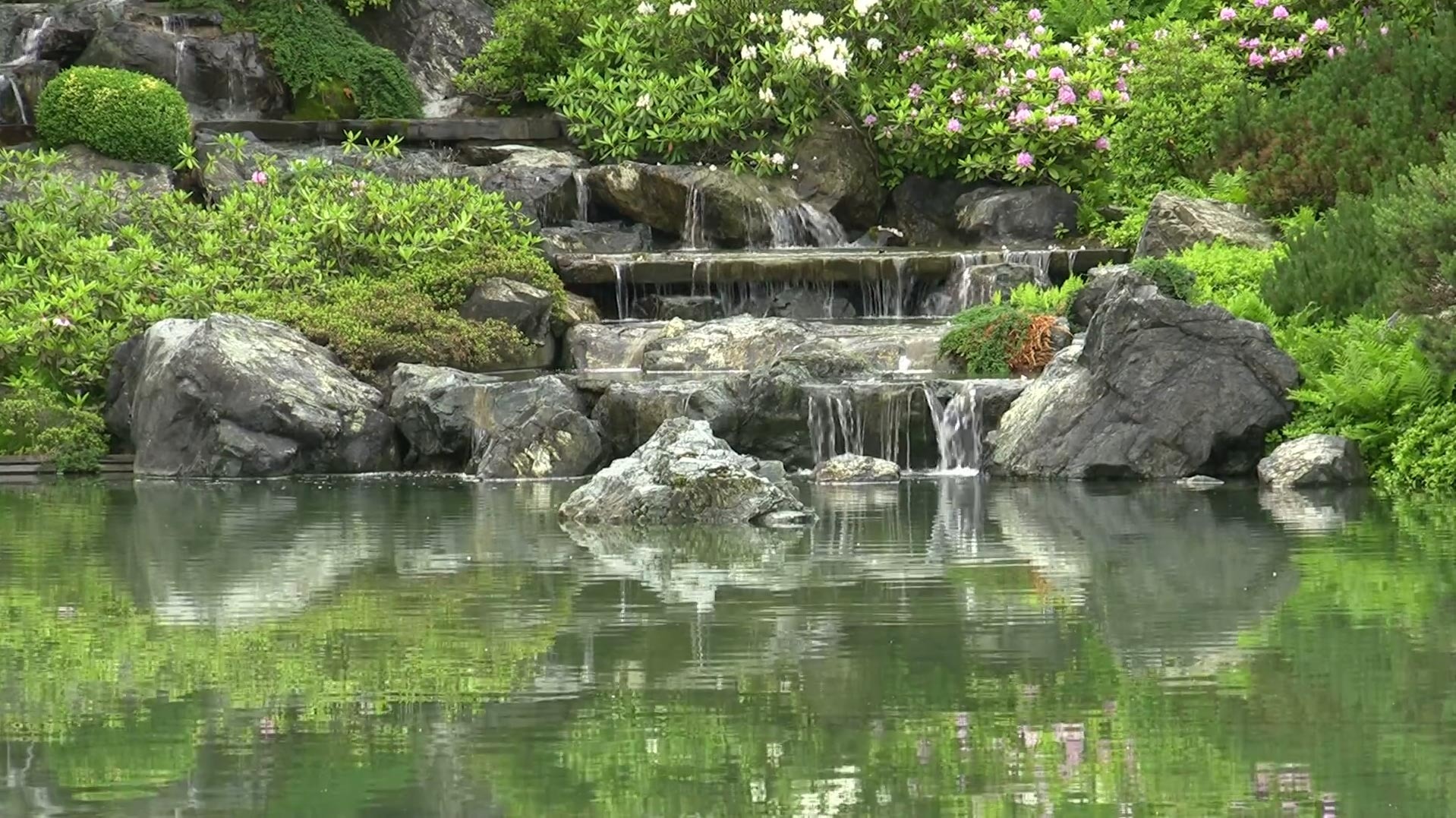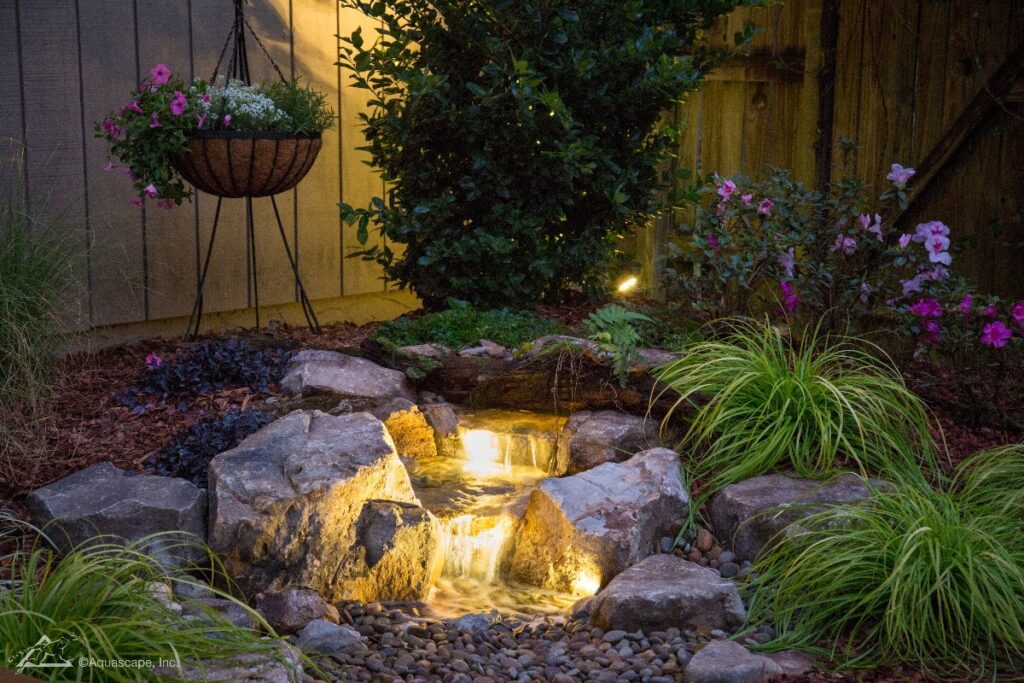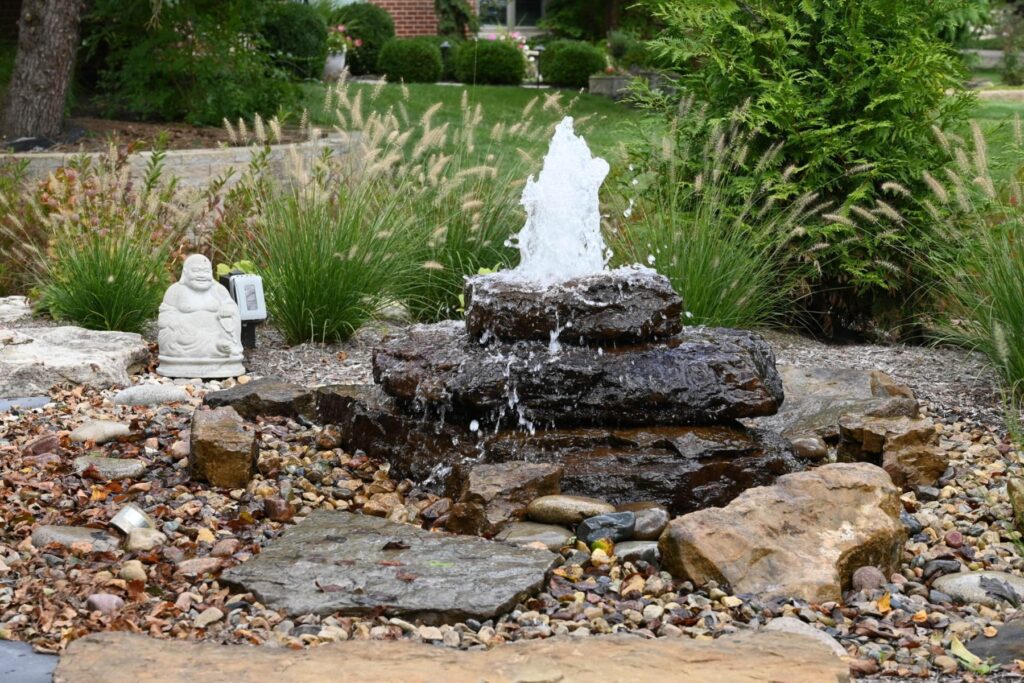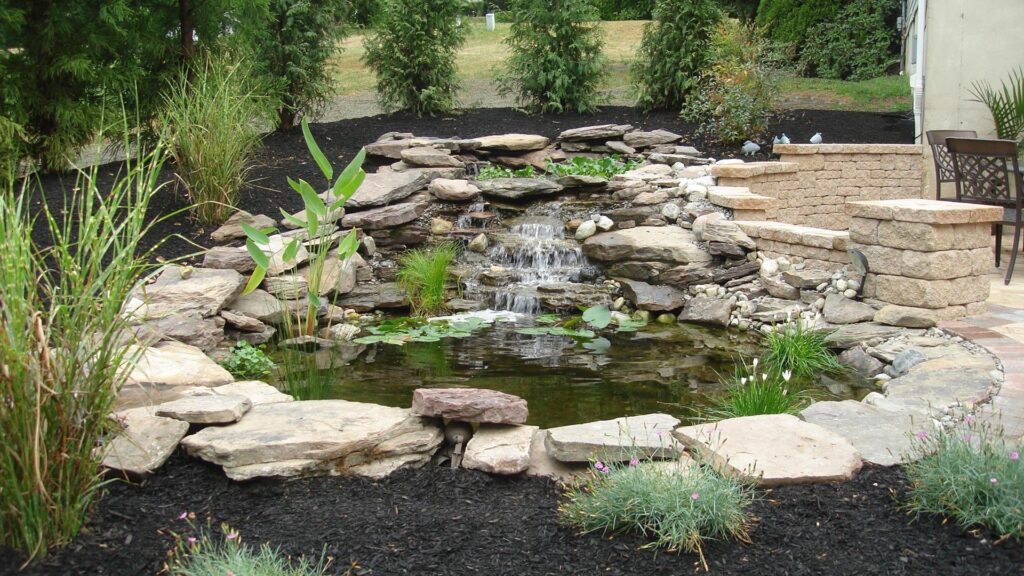
Water features transform outdoor spaces into serene, functional environments. They not only improve visual interest but also invite movement, sound, and life into the garden.
Enhancing mood and supporting local wildlife, they offer both aesthetic and practical value. Let us talk about what is the best ways to use different features.
Table of Contents
Types of Water Features
Adding water features introduces motion, texture, and sound into outdoor spaces in ways that engage all the senses.
These elements can serve as central attractions or subtle enhancements, depending on design goals and space constraints.
Each type brings distinct visual effects, acoustic qualities, and maintenance needs.
Selecting the right feature involves more than just aesthetics, it requires consideration of available space, personal preferences, and functional benefits.
Ponds

Source: jfdlandscapes.com
Ponds offer a tranquil centerpiece that can be designed either as a thriving ecosystem or a decorative installation.
They often house aquatic plants such as water lilies, lotus, and reeds, creating a biodiverse space that invites pollinators and beneficial insects. Including fish like koi or goldfish adds motion and vibrancy, while also helping manage insect populations naturally.
Edges can be softened with rock borders, wetland plants, or surrounding seating areas.
Placement should avoid full shade to ensure healthy plant growth, adequate sunlight penetration, and water clarity. Proper filtration systems and occasional cleaning maintain water quality over time.
- Key characteristics: ecosystem or decorative, supports fish and aquatic plants, suited for medium to large areas
Fountains
Fountains range from classical tiered structures to sleek, sculptural pieces or discreet wall-integrated styles. Their constant flow adds soothing sound and movement to the space, masking urban noise or adding tranquility to gardens and courtyards.
Wall-mounted fountains are especially suited for tight areas such as patios or entryways.
Materials such as stone, copper, concrete, or stainless steel allow fountains to align with different architectural tones. Many models use self-contained reservoirs, simplifying installation and reducing space demands.
Subtle LED lighting and programmable spray patterns can enhance both day and night aesthetics. If you are interested in finding a fountain, you can find on this link the option that will fit your landscape design.
- Key characteristics: tiered, sculptural, or wall-mounted, variety of materials, adaptable for space constraints
Waterfalls

Source: grassperson.com
Waterfalls often connect with ponds or rock structures, forming an eye-catching focal point with auditory impact. Elevation adds vertical interest, while the motion of water introduces a sense of rhythm and liveliness.
Designs range from natural rock cascades to clean, modern sheet falls. Some installations use hidden catch basins and recirculating pumps for minimal maintenance and safer, drier surroundings.
In larger projects, waterfalls can be built into retaining walls or garden slopes. These features require consistent water flow, proper grading, and thoughtful integration with adjacent elements.
- Key characteristics: integrated with ponds or rocks, visual and auditory interest, natural or stylized flow
Streams
Streams offer naturalistic movement through the garden, guiding the eye and providing soothing sound. Ideal for larger properties, they can meander through the space, creating organic lines and flow.
Paired with footbridges, stepping stones, or native plants, streams enhance visual transitions between different zones.
Depth is typically shallow, but they can support small fish or frogs. Strategic grading and pump circulation ensure water moves at a consistent, lifelike pace.
Design should account for runoff, water loss, and erosion control to maintain sustainable function.
- Key characteristics: suited for large spaces, flowing design, supports wildlife
Bubbling Rocks

Source: wassonnursery.com
Bubbling rocks are perfect for small spaces and require minimal maintenance.
Water bubbles up through a drilled stone, recirculating into a hidden basin below the surface. Sound remains gentle and localized, creating a peaceful ambiance without overwhelming background noise.
These features are ideal for entry gardens, patios, or meditation spaces. They also provide a safe option for families with children or pets, since there’s no open water. Installation is often straightforward and can be completed with basic excavation and plug-in pump systems.
- Key characteristics: compact design, minimal upkeep, safe for children and pets
Hybrid Features
Combining water features, like a waterfall flowing into a pond or a fountain feeding a stream, amplifies visual dynamics and sound layers.
These integrations allow for greater personalization and complexity, uniting multiple sensory elements into one cohesive system.
Projects may include transitions between vertical and horizontal water motion, multiple reservoirs, and varied lighting schemes.
Hybrid designs require more planning and infrastructure but offer highly customized results that suit larger or more intricate outdoor environments.
- Key characteristics: combined elements, customized setups, multidimensional aesthetics
Architectural and Design Principles

Source: lotuslandscapes.in
Thoughtful design brings structure and cohesion to outdoor environments that feature water elements. Success depends on how each component fits into the whole.
Factors such as size, symmetry, material, and positioning must work together to create a visually pleasing and practical outcome.
Proper alignment between the water feature and its surroundings transforms a simple installation into a focal point that elevates the space.
Key design principles to consider are outlined below in bullet points for clarity and effective planning.
Scale and Proportion
Visual harmony depends on proper sizing. An oversized pond can dominate a small backyard, while a modest bubbling rock might become invisible in a spacious garden.
The goal is to strike a balance that allows the feature to complement, not overwhelm.
Taller structures like fountains and waterfalls should align with surrounding plants, hedges, or vertical accents.
- Large features for expansive yards: streams, large ponds, multi-tiered waterfalls
- Small or mid-size features for compact areas: bubbling rocks, wall fountains
- Vertical features should align with nearby trees or shrubs
- Horizontal spread should stay within one-third of the surrounding open space
Balance and Symmetry
Visual balance sets the tone for how formal or informal the space feels.
Symmetrical arrangements create order and structure, often seen in classical or European-inspired gardens. Asymmetry offers a more organic flow, appropriate for naturalistic designs.
Balance isn’t limited to visual weight but also involves the distribution of texture, color, and scale.
- Use symmetry for formal layouts: matching planters, mirror-image plantings
- Embrace asymmetry for natural flow: staggered boulders, varied plant groupings
- Repetition of similar forms or textures enhances consistency
- Avoid clustering all elements on one side of a focal area
Color, Texture, and Material Use

Source: thepioneerwoman.com
Every material and color used should reflect the design intent. Rough-cut stone, gravel, and driftwood create a rugged, earthy feel.
Sleek metals and polished concrete introduce a modern tone.
Surrounding the water feature with plants softens hard edges and layers the visual experience. Strategic lighting enhances color variation and highlights textures after sunset.
- Use dark stones to contrast with light foliage
- Match materials with architectural elements (brick, siding, fencing)
- Add plants with varying leaf shapes and bloom times
- Install underwater lights or uplighting to emphasize texture
Circulation and Placement
Location affects both safety and enjoyment. A well-placed water feature can draw visitors through the garden or provide a relaxing view from a porch.
Avoid awkward placements that interrupt flow or become hazards.
Flat paths and nearby seating extend the feature’s usability, turning it into a destination rather than just an accent.
- Ensure visibility from windows, decks, and entry points
- Avoid blocking access paths with bulky design features
- Use non-slip materials for nearby walkways
- Add benches, low walls, or boulders for resting spots
The Bottom Line
Adding a water feature brings movement, sound, and vitality into any outdoor area.
Choosing the right type, size, and placement sets the stage for a balanced and peaceful retreat.
Personalized choices ensure the space reflects individual style while offering lasting beauty and function.







